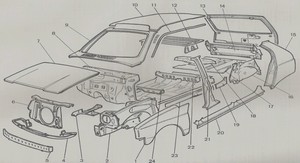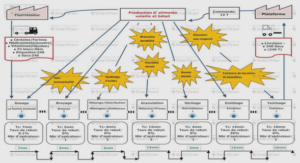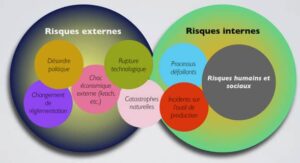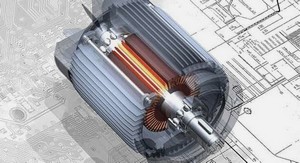Aeroelastic Rotorcraft-Pilot Couplings
Helicopter basics
An explanation of what are the controls a pilot has at disposal and how they act on a helicopter is proposed in the next paragraph, readers who are familiar with rotorcrafts should jump to the next section. A helicopter has the capability to fly in any spatial direction and perform hover flight, thanks to a variable magnitude and orientation of the rotor thrust vector, see Figure The rotor thrust vector is the sum of the individual blade aerodynamic forces. So far, in actual technologies, the rotor angular velocity is maintained constant; as a result the variations of both magnitude and orientation of the thrust vector can only be obtained by modifying the pitch of the main rotor blades. This modification can be done, – Collectively: constant individual blade pitch per rotor revolution. This is achieved by translating vertically the swashplates see (b) Figure 1-4. The norm of the thrust vector is modified by a constant collective blade pitch angle through the collective pitch lever see Figure 1-3. – Cyclically: varying individual blade pitch per rotor revolution. This is achieved by changing the orientation of the swashplates see (b) Figure 1-4. For pitch and roll helicopter orientations, the pilot has to modify the cyclic pitch lever angles in one or a combination of the two directions Figure 1-3.A particularity of conventional helicopter architectures is that a torque around the yaw axis is generated by the main rotor on the airframe. A tail rotor has to be implemented to counter act this torque thanks to the tail force vector see Figure 1-4. This force vector norm can be adjusted by the pilot thanks to the pedals see (b) Figure 1-3. At this point, the reader should note that all the axis of the helicopter are coupled: a modification of any of the controls (collective, cyclic, pedals) will need an iterative corrective action on all of them. Behind the unique VTOL (Vertical Take-Off and Landing) and hover flight capabilities of helicopters, one can already have an idea of the complexity of the machine. Even if this investigation will focus on conventional helicopters, one should keep in mind the methods used in this work could still be applicable to other rotorcraft architectures such as Figure 1-6 examples.
Bioaeroelasticity
Very practically, the Figure 1-7 shows unusual helicopter roll oscillations that appeared during a flight test many years ago around Marignane airport. The comments in orange were written down by the engineer that compiled the report. What can be seen is that during the flight both pilot and fuselage oscillations are unusually amplified to a certain point (orange arrows) before decreasing. The report states that the pilot inputs seem to be at the origin of the phenomena but that considering the frequency of the signal (>2Hz) it is too high to be a voluntary action of the pilot.By discussing3 with a Royal Netherlands Air force Boeing AH-64D Apache pilot, it appeared that sometimes pilots can feel unusual cockpit vibrations while piloting. In some cases they realize they are participating in the vibratory event by for example holding ‘too tight’ the controls. If they are in a situation in which they can, releasing the controls can help attenuating the phenomena; however this is far from being an acceptable solution. The first investigations around these kind of phenomena, known as Aircraft-Pilot Couplings (APCs) are reported in the fixed wing aircraft industry, for which a general definition is proposed by (McRuer, 1995) these are “inadvertent, sustained aircraft oscillations which are a consequence of an abnormal joint enterprise between the aircraft and the pilot”. Recently, the Aristotel (2010-2013) European research project devoted to the investigation of RPCs has categorized the phenomenon into two categories depending on the frequency of the oscillations: ‘rigid’ below 1Hz and ‘aeroelastic’ ones between 2 and 8Hz (Pavel, et al., 2013). The term aeroelastic comes from the nature of the forces in interaction: aerodynamic, inertial and elastic4 forces. As suggested in (Masarati & Quaranta, 2014), the term aeroelasticity is extended to bioaeroelasticity when additional forces generated by human biodynamics need to be taken into account.Due to the harsher vibratory environment of rotorcraft compared to fixed wing aircrafts, rotorcraft designs are more sensitive to aeroelastic phenomena and therefore aeroelastic RPCs. These phenomena have a critical impact on safety since they can be at the origin of undesirable vibrations, limit cycle oscillations or instabilities. Even if RPCs are not always unstable, vibrations and limit cycle oscillations are uncomfortable for the passengers and a source of alternative loads that fatigue the materials and reduce the lifetime of aircrafts, limiting their performances. So far, most research efforts have concentrated in the prediction of aeroelastic RPCs on the vertical axis of helicopters. In (Mayo, 1989), based on simulator experimental results a vertical pilot biodynamics model is proposed and then coupled to a high order linear helicopter model to simulate potential Pilot-Assisted Oscillations (PAOs) in the vertical axis of helicopters, and to design a filter of selected pilot’s inputs capable of alleviating the phenomena. In (Gennaretti, et al., 2013), very detailed helicopter models are developed to predict vertical instabilities associated to PAOs/RPCs. In (Masarati & Quaranta, 2014), detailed nonlinear models of pilot’s left arm acting on the collective lever and a helicopter model are coupled to investigate vertical PAOs. This approach constitutes one of the first attempts to predict the involuntary behavior of the pilot using physical principles. This involuntary behavior has been formalized as quantity known as biodynamic feedthrough. A definition is proposed by (Venrooij, 2014): “the transfer of accelerations through the human body during the execution of a manual control task, causing involuntary forces being applied to the control device, which may result in involuntary control device deflections”. One can immediately imagine this quantity might appear in any vehicle and not just aircrafts. It is recognized in (Walden, 2007) that the lateral axis for PAOs tends to be more critical. In (Lantzsch, Hamers, & Wolfram, 2014), the development of a controller is reported to cancel the emergence of a roll oscillatory phenomenon (around 1.8 Hz) when closing the roll rate feedback of a stability augmentation system of an Airbus helicopter H135 (previously known as Eurocopter EC135). A contribution to understanding the physical mechanisms between the potential interactions of an automatic flight control system (AFCS) and lateral helicopter dynamics can be found in (Pavel & Padfield, 2008) and (Pavel M. , 2010), especially about the complex energy flows between blade flap, lag and the airframe roll motion in the presence of an AFCS. In (Muscarello, et al., 2015), linear aeroservoelastic models were coupled to pilot biodynamic models derived from simulator experimental excitation and compared to flight simulator experimental trials. Interesting conjectures are drawn: “predictions suggest that the roll/lateral PAO phenomena are more likely to occur on helicopters with soft in-plane rotors that have lightly damped in-plane rotor modes, more sensitive to time delay than gearing ratio with respect to the lateral cyclic control, more dangerous when the flight speed increases and more likely to occur with pilots that are characterized by a natural frequency of the biodynamic poles that is close to the lightly damped in-plane rotor mode”.




